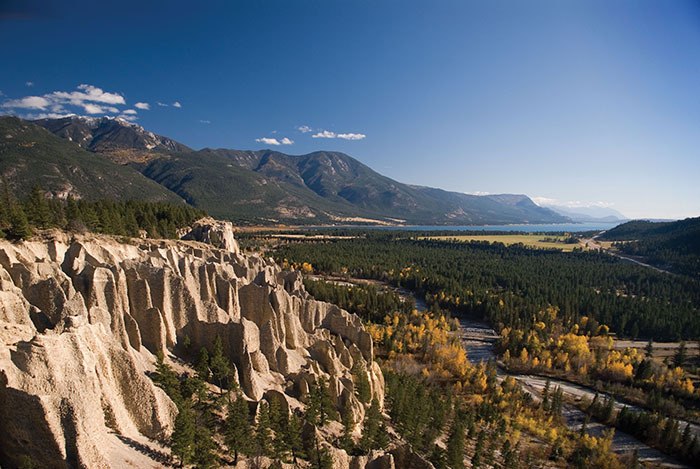A plan to upgrade Columbia Lake Provincial Park is in the works, but a draft proposal by BC Parks prohibiting motorized access to the north end of Columbia Lake is being met with an icy reception by the community of Fairmont Hot Springs.
“There have been several letters written by different community groups in Fairmont saying we want to have access to the lake, and it’s supported in our Official Community Plan and the Columbia Lake Management Strategy, and all of our policy documents support access at the north end for the community,” said Regional District of East Kootenay Area F director Wendy Booth. “We all deserve access to our lake.”
The 257-acre provincial park — accessed through Fairmont along Columbia Lake Road heading south — has been neglected over the years due to the uncertainty surrounding the future of Lot 48, the 300-acre parcel of land located at the park’s south end.
Since the Nature Conservancy of Canada purchased Lot 48 in 2012, BC Parks has turned its focus back on the park, which sits between the lot and the community of Fairmont.
Earlier this year, BC Parks staff met with Ms. Booth and several Fairmont community leaders to present a draft of proposed upgrades that included improving the safety of two kilometres of Columbia Lake Road from Fairmont into the park, installing a gate and sign at the park’s entrance to deter overnight camping, and decommissioning the access road down to the north end of the lake.
“It’s a very, very bad road that’s deteriorated over the years, and you basically need a four-wheel drive vehicle down there,” said Ms. Booth, noting the access road is actually an old creek bed that people drive down to an area allowing for 10 to 12 vehicles.
“(But) it’s the only lake access; there is no other way to get to the lake at the north end.”
The draft proposal also included the development of a parking lot at the top of the creek bed with pit toilet facilities, the construction of a two-metre wide gravel bed path to the lake — roughly a 450-metre distance — and the installation of a locked gate just beyond the current lake access prohibiting motor vehicle access to Lot 48.
“There were about eight to ten of us in the room; it was felt that the community deserves to have access to the lake without having to walk that far,” said Ms. Booth.
The group proposed a compromise, requesting that the road be kept open, “so that dad can drive down here and drop off the kids and the lawn chairs and cooler and kayak and floaty toys, then park up top and walk back down,” said Ms. Booth, but that parking at the bottom be eliminated.
“That would give accessibility for the elderly and the people who aren’t as mobile,” she said.
In November, Ms. Booth met with BC Parks staff in Cranbrook, at which time she was shown a detailed design of the revised upgrades that revealed the parking lot had been set back a further 300 metres.
“So now it’s a 750-metre walk down to the lake,” she said. “Here we are trying to enable tourism and BC Parks should be our partner in that.”
Told that the final decision lay with BC Parks in consultation with park stakeholders and that First Nations were on board with the plan, Ms. Booth wonders why the input from Fairmont’s community groups is not being considered.
“The average Joe on the street should be able to access the lake as opposed to having to buy a high-end property to use the lake, which is basically how the north end of the lake is,” she said. “I understand (BC Parks) are just looking at their piece but the community is looking at the whole north end.”
“Protecting an area such as this falls directly in line with Ktunaxa stewardship principals,” said Ktunaxa Nation Council communications manager Jesse Nicholas. “The Ktunaxa Nation Council supports BC Parks’ efforts to mitigate environmental impacts in the area.”
Furthermore, the cultural sensitivity is of crucial importance, he added.
“As the Ktunaxa have lived in this area for over 10,000 years, all archaeological sites are a vital part of our collective history and must be preserved and protected,” he said. “Many sites in the Territory occur within the first 10 centimetres under the ground surface, and are therefore vulnerable to destruction through ground-altering activity, including the use of motorized vehicles.”
According to Ministry of Environment spokesperson Dave Crebo, the proposed access trail from the parking lot to the lakeshore is 520 metres, and park upgrades also include rehabilitation of the riparian area and damage from the existing access.
“The park has a concentration of 21 species at risk and many archaeological sites that are vulnerable and much damage has occurred by off-road vehicles,” he said. “BC Parks has tried to balance the desire for improved recreational access with protection of natural and cultural values; this proposed change would reduce impacts from off-road vehicles, and park users gain additional hiking trail.”
The owners of Lot 48, the Nature Conservancy of Canada, support restricting motorized activity beyond the proposed parking area and the portion of the current road beyond the proposed parking area is proposed to become walking trails leading to both Lot 48 and the beach, he added.
BC Parks will hold a public open house in February or March (date TBA) at which time members of the public will have an opportunity to provide comment that will be considered for the final design. The upgrade work may begin in 2014, said Mr. Crebo.
